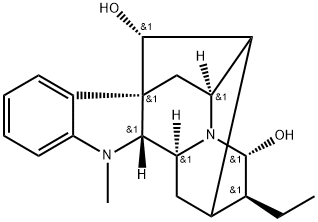Rauwolfia (Luo Fu Mu) is derived from the plants Rauvolfia verticillata (Lour.)
Baill. and R. yunnanensis Tsiang, and the root is usually used as its medicinal part.
R. verticillata (Lour.) Baill. var. hainanensis Tsiang and R. vomitoria Afzel. ex
Spreng have been also used as traditional Chinese herb.
Rauwolfia is one of the important traditional herbs in southern China. Its scope
of treatment includes cold, fever, sore throat, headache, and dizziness caused by
hypertension, abdominal pain and diarrhea, scabies, and so on. Rauwolfia is also
used to treat insomniac dizziness, bruises, sprains, and venomous snake bites in
folk.
In the “Flora of China,” 135 species of Rauwolfia were recorded, mostly distributed in the tropics and subtropics, a few in the temperate regions. There are nine
species, four varieties, and three cultivated species in China.
Appearance: white or yellowish crystal powder. Melting point: its anhydride is 205–
207?°C. Optical rotation: +144° (chloroform). Solubility: well soluble in organic
solvents, such as methanol, ethanol, etc., and slightly soluble in water. Storage tem�perature: 2–8?°C.
Since 1930s, abundant studies have been focused on the Rauwolfia plants. So far, a
total of 91 alkaloids were separated from Rauwolfia, and the identification of the
chemical structures was obtained, including 2 non-indole alkaloids (thebaine and
papaverine) and 89 indole alkaloids . In accordance with the basic framework,
indole alkaloids can be divided into seven classes, such as the ajmaline class, the
For use as an antiarrhythmic agent.
An antiarrhythmic agent isolated from Rauwolfia serpentina.
ChEBI: A monoterpenoid indole alkaloid that consists of ajmalan substituted at positions 17 and 21 by hydroxy groups.
Ajmaline isolated from Rauwolfia sp. roots: Rauwolfia serpentine Benth.,
Rauwolfia vomitoria Afr., Rauwolfia canescens L.
Threshed roots of Rauwolfia canescens L. extracted with 5% solution of acetic
acid at room temperature for 24 h. Then extract was decanted to flask. This
extract was alkalified with ammonia (alkaloid salts were converted to alkaloid
bases). The obtained thus method solution was extracted with chloroform 3 or
more times. Then chloroform extract was chromatographed on column
through Al2O3 sorbent. After chromatography ajmalin was obtained, which had
melting point at 205°C (recyrstallization from methanol).
Anti-arrhythmic
R. serpentina (She Geng Mu) is the first anti-arrhythmic herbal medicine in the
psychiatry history. Ajmaline has a potent anti-arrhythmic effect for treating atrial and ventricular arrhythmias and also has a good effect on the treatment of
Wolff-Parkinson-White syndrome. Ajmaline plays a main role in decreasing the
permeability of sodium ion on the myocardial cell membrane by moderately inhibiting the sodium channel. The electrophysiological effect of ajmaline is similar to that
of quinidine, but it is stronger than quinidine.
In addition, ajmaline has a mild anti-sympathetic effect. It affects sympathetic
nerve endings to release more sodium, dilate the coronary artery, relax vascular
smooth muscle, and then decrease blood pressure. Therefore, it is suitable for clinical treatment of atrial and ventricular premature beats, pre-excitation syndrome
with supraventricular tachycardia, but not suitable for the treatment of paroxysmal
atrial fibrillation and sinus tachycardia.
Ajmaline has the anti-arrhythmic effects for the treatment of atrial or ventricular
extrasystoles, paroxysmal supraventricular or ventricular tachycardia, and paroxysmal atrial fibrillation. The lethal dose for human ranged from 100 to 500?mg/kg.
Side effects
include disturbances of the central nervous system
and intrahepatic cholestasis.
Ajmaline crystallises from MeOH or EtOAc containing a little H2O to give the trihydrate m 158-160o. This loses 1H2O at 110o and all H2O at 150o. [Beilstein 23 III/IV 3212.]
Le Gall., Ann. ph arm. franc., 18,817 (1960)
